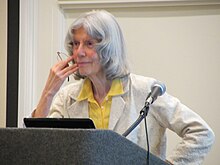Eleanor Rosch(once known asEleanor Rosch Heider;[1]born 9 July 1938[2])[3]is an Americanpsychologist.She is aprofessorof psychology at theUniversity of California, Berkeley,[4]specializing incognitive psychologyand primarily known for her work oncategorization,in particular herprototype theory,which has profoundly influenced the field ofcognitive psychology.
Eleanor Rosch | |
|---|---|
 | |
| Born | Eleanor Rosch 9 July 1938 |
| Education | Harvard(Ph.D.) |
| Scientific career | |
| Fields | Cognitive science,psychology,philosophy |
| Institutions | University of California, Berkeley Brown University Connecticut College |
Throughout her work Rosch has conducted extensive research focusing on a range of topics, including semantic categorization,mental representationofconcepts,andlinguistics.[5]Her research interests include cognition, concepts, causality, thinking, memory, and cross-cultural, and Eastern and religious psychology. Her more recent work in the psychology of religion has sought to show the implications ofBuddhismand contemplative aspects of Western religions for modern psychology.
Early life and education
editRosch was born in New York City, the daughter of an English teacher from England and a mother who was a Russian refugee.[6]She completed an undergraduate philosophy thesis atReed CollegeonWittgenstein,who she said "cured her of studying philosophy."[citation needed]
After school, she served as a social worker in Portland for several years, returning later to Harvard to study clinical psychology at the then-Department of Social Relations. Rosch delivered a paradigm-changing[7]doctoral thesis atHarvardabout category formation, under the direction of Roger Brown. After a short stint atBrown UniversityandConnecticut College,Rosch joined the Department of Psychology at University of California, Berkeley in 1971.[8][9]
Research
editFrom field experiments Rosch conducted (alongside her then-husbandKarl Heider) in the 1970s with theDani peopleofPapua New Guinea,she concluded that when categorizing an everyday object or experience, people rely less on abstract definitions of categories than on a comparison of the given object or experience with what they deem to be the object or experience best representing a category ( "prototype" ).[citation needed]
Although the Dani lack words for all the English colors (their language contained only two color terms dividing all colors into either the "light, bright" category or the "dark, cool" category), Rosch showed that they could still categorize objects by colors for which they had no words. She argued that basic objects have a psychological import that transcends cultural differences and shapes how such objects are mentally represented. She concluded that people in different cultures tend to categorize objects by using prototypes, although the prototypes of particular categories may vary.[1]
Rosch contributed to multiple scholarly works of taxonomic analysis of objects based on these prototype ( "chair" ) and subordinate terms ( "tall black leather chair" ). She inferred that overuse of subordinate terms could be attributed to the attitude of snobbery and elitism.[10]
Her work has been often referenced by that of computer vision and deep learning researcherAude Oliva,who has built upon Rosch's object classifications to teach computers to recognize basic scenes instantly interpreted by humans.[citation needed]
Publications
editBooks
edit- 1978 (with Lloyd, B., eds).Cognition and Categorization.Hillsdale NJ: Lawrence Erlbaum Associates.[10]
- 1991 (withFrancisco Varelaand Evan F. Thompson).The Embodied Mind.MIT Press.
Book chapters
edit- 1973, "On the Internal Structure of Perceptual and Semantic Categories." In T. Moore (ed.),Cognitive Development and the Acquisition of Language,New York: Academic Press, 1973.
- 1974, Linguistic relativity. In: E. Silverstein (ed.) Human Communication: Theoretical Perspectives, Hillsdale, NJ: Lawrence Erlbaum.
- 1977, "Human Categorization" in Warren, Neil, ed.,Advances in Cross-Cultural Psychology 1:1-72. Academic Press.
- 1983, "Prototype classification and logical classification: The two systems" in Scholnick, E.,New Trends in Cognitive Representation: Challenges to Piaget's Theory.Hillsdale, NJ: Lawrence Erlbaum Associates: 73–86
Papers
editCategorization and prototype theory
edit- Rosch, E.H. (1973). "Natural categories".Cognitive Psychology.4(3): 328–50.doi:10.1016/0010-0285(73)90017-0.
- Rosch, R.H. (1975). "Cognitive reference points".Cognitive Psychology.7(4): 532–47.doi:10.1016/0010-0285(75)90021-3.S2CID54342276.
- 1975, "Cognitive representation of semantic categories,"Journal of Experimental Psychology104(3): 192–233.
- Rosch, E.H.; Mervis, C.B.; Gray, W.D.; Johnson, D.M.; Boyes-Braem, P. (1976). "Basic objects in natural categories".Cognitive Psychology.8(3): 382–439.CiteSeerX10.1.1.149.3392.doi:10.1016/0010-0285(76)90013-X.S2CID5612467.
- Mervis, C.B.; Rosch, E. (1981). "Categorization of Natural Objects".Annual Review of Psychology.32:89–113.doi:10.1146/annurev.ps.32.020181.000513.
Psychology of religion
edit- Eleanor Rosch (2002)."How to catch James's mystic germ: Religious experience, Buddhist meditation and psychology".Journal of Consciousness Studies.9(9–10): 37–56.ISSN1355-8250.
- Eleanor Rosch (2003)."The basis of compassion: Western science in dialog with the Dalai Lama".PsycCRITIQUES.48(3): 330–332.doi:10.1037/000807.ISSN1554-0138.
- Eleanor Rosch (2007). "More than mindfulness: When you have a tiger by the tail, let it eat you".Psychological Inquiry.18(4): 258–264.doi:10.1080/10478400701598371.ISSN1047-840X.S2CID144196114.
- Eleanor Rosch & Eman Fallah (2007). "Science and religion, Dalai Lama style".PsycCRITIQUES.52(20): np.doi:10.1037/a0007895.ISSN1554-0138.
Awards and recognition
editRosch is a Fellow of the Cognitive Science Society.[11]She has mediated several discussions with theDalai Lama.
See also
editReferences
edit- ^ab"Natural Categories", Cognitive Psychology, Vol. 4, No. 3, (May 1973), p. 328.
- ^Profile of Eleanor Rosch
- ^Eleanor Rosch - School of Information Science - Hall of Fame
- ^Eleanor Rosch, MIT Press website
- ^Rosch, Eleanor (September 1975). "Cognitive representations of Semantic Categories".Journal of Experimental Psychology: General.104(3): 192–233.doi:10.1037/0096-3445.104.3.192.
- ^"Dialog on Leadership: Professor Eleanor Rosch Interview".iwp.jku.at.Retrieved2018-11-13.
- ^Levitin, Daniel (2006).This Is Your Brain on Music: The Science of a Human Obsession.New York: Dutton. p. 141.ISBN9780525949695.Retrieved2015-08-13.
- ^Heider, Eleanor Rosch (October 1971). "Information Processing and the Modification of an 'Impulsive Conceptual Tempo'".Child Development.42(4): 1276–81.doi:10.2307/1127811.JSTOR1127811.PMID5157116.
- ^Heider, Eleanor Rosch; Olivier, Donald C. (April 1972). "The structure of the color space in naming and memory for two languages".Cognitive Psychology.3(2): 337–354.doi:10.1016/0010-0285(72)90011-4.
- ^abRosch, Eleanor (1978).Cognition and Categorization.Hillsdale, NJ: Lawrence Erlbaum. pp. 1–25.
- ^"Fellows | Cognitive Science Society".cognitivesciencesociety.org.Archived fromthe originalon 2018-09-26.Retrieved2018-11-13.
External links
edit- Faculty page for Eleanor Roschat the Department of Psychology at theUniversity of California, Berkeley
- Eleanor Rosch's web page on Pitt's Information Science Hall of Fame